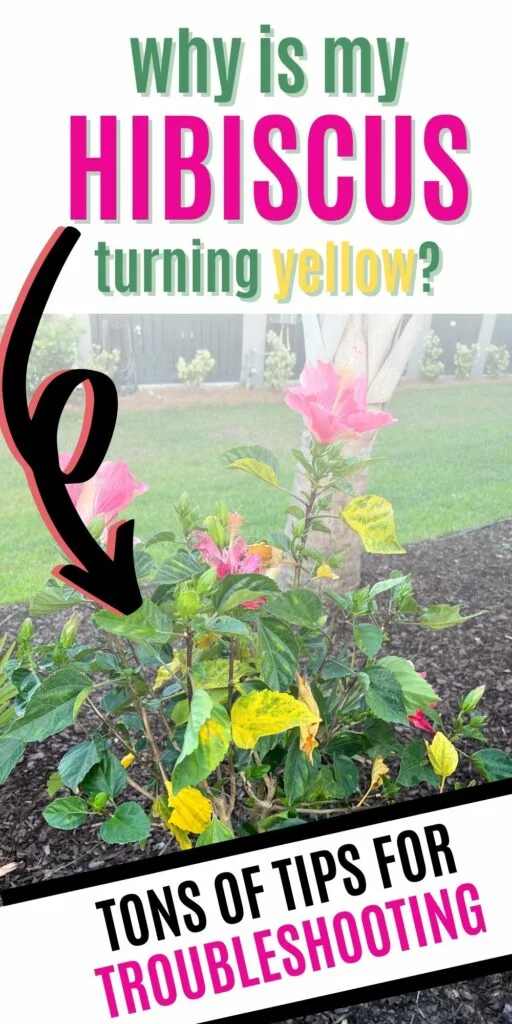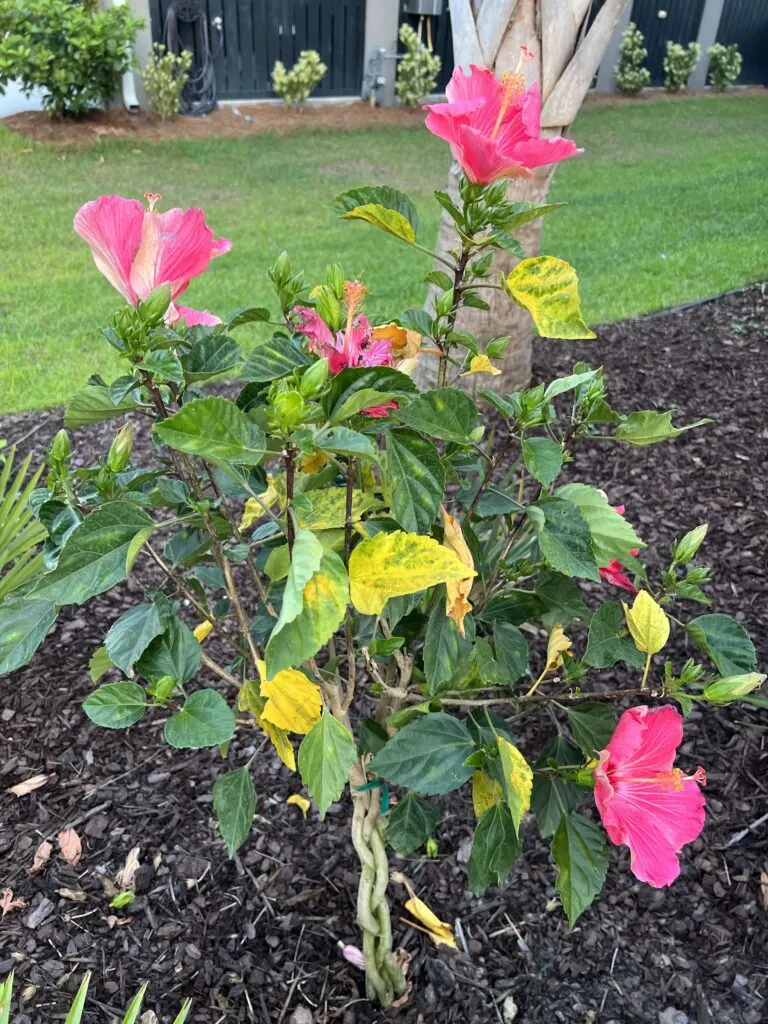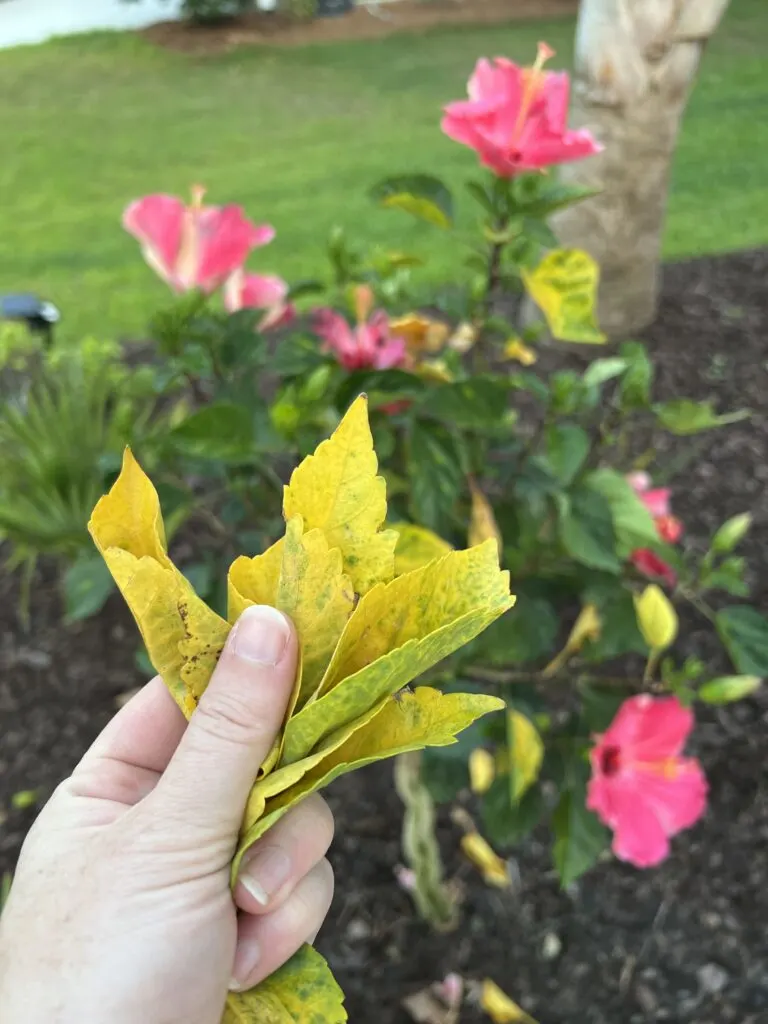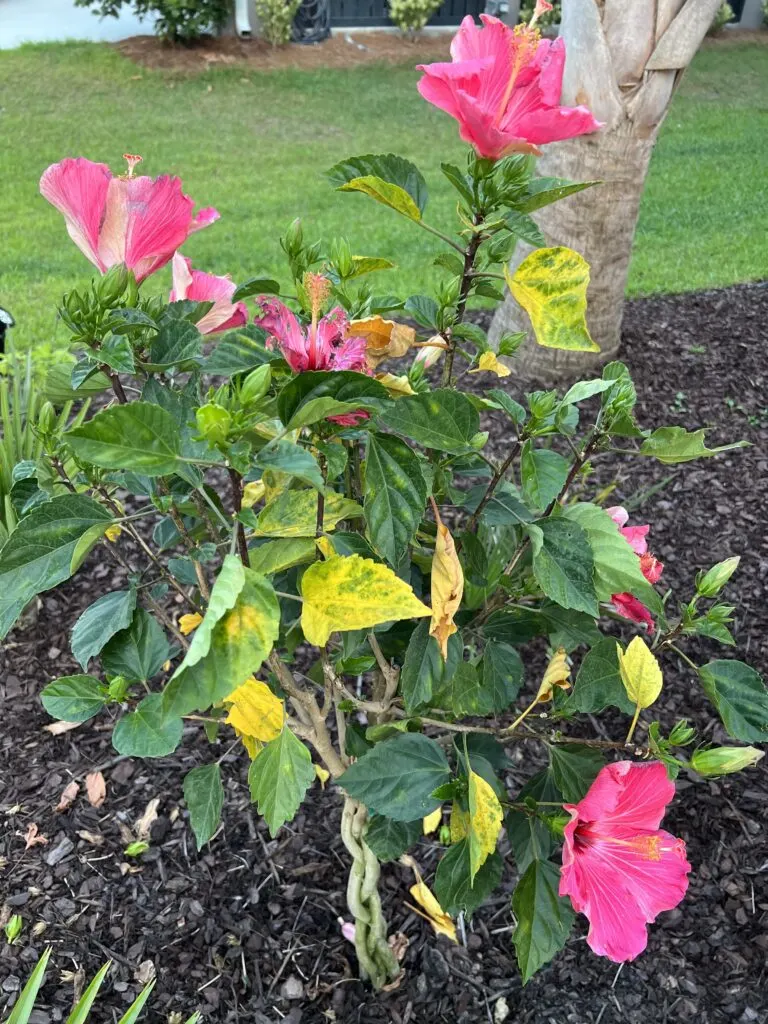Is your hibisus getting yellow leaves? Here’s what is causing it and what you can do to save this gorgeous plant!
I absolutely adore hibiscus plants. They have a beautiful green foliage but you cannot beat the big colorful flowers. They just transport me straight to Hawaii!
These plants make beautiful shrubs and will come back year after year if you choose hardy varieties and live in a warm enough climate.
So, if the leaves are turning yellow and dropping off – that can be a big bummer.

Why do my hibiscus have yellow leaves?
There are a few main causes of yellow leaves on a hibiscus plant:
- Overwatering
- Low humidity
- Inconsistant watering
- Insufficient light
- Nutrient deficiency
- Root bound plant
- Bacterial Leaf Spot
- Pests
- Hot or cold temperatures
- Old age
Overwatering
Overwatering is the #1 cause of yellowing leaves on most plants. In general, plants don’t like to sit in excess water. Pooling water can lead to root rot which will kill your plant.
If you suspect overwatering, stick your finger about 2 inches into the soil. Does it feel wet? Don’t water again until it dries out.
If your plant is way over watered, take it out of the pot. Dump out any excess water and wet soil and re-pot with fresh potting mix.
If the plant is potted, be sure that your pot has drainage holes to prevent excess water from pooling in the future.
For plants in the ground, you want to be sure that it is well-draining soil. Here are our best tips for how to plant plants in clay soil.
Low humidity
I find this to be MUCH less frequent than over watering, but low humidity can cause leaf drop. Usually the leaves will get brown, crispy spots on them (often on the tips). Then, the leaves might turn yellow.
These symptoms indicate that the plant is drying out. If it’s being watered well, misting the leaves can help to improve humidity in the air.
Inconsistant watering
Going from bone dry to soaking wet at random intervals could stress out your plant and lead to yellowing leaves.
If in doubt, establish a regular watering schedule and try to stick to it.

Insufficient light
Hibiscus plants like plenty of bright light – at least 6 hours a day. The more leaves that they have, the more light that they need. Leaves in the shade – even in the shade of other leaves on the same plant – tend to yellow.
If your plant isn’t getting enough light, the leaves will start to turn yellow and drop. This will especially happen to older leaves towards the base of the plant.
The cure to this is to move your plant into bright, indirect light. It will be much happier.
Nutrient deficiency
Another cause of yellowing leaves can be a nutrient deficiency. This is solved by applying a hibiscus fertilizer. Beware – too much fertilizer can also cause yellowing and dropping leaves!
Root Bound Plant
It is possible that your potted plant has become root bound. Basically, the roots are too big for the pot.
Pull it out of the pot and see! If it’s been there a while – this is a real possibility.
If the roots are tightly packed or even poking out the drainage hole – time for a bigger pot. Add fresh potting soil while you are at it for a happier plant!
If the plant is in the ground, check the soil to see if it is very compact and needs to be aerated at all.

Bacterial Leaf Spot
Soft, brown, mushy spots on a leaf are called Bacterial Leaf Spots. This come from water sitting on the leaves and rotting them.
Remove all effected leaves and avoid getting the leaves wet when you water it!
Pests
Pest attacks can happen. Thrips, Spider Mites, Aphids, Whiteflies, Mealybugs, and Japanese Beetles can get on the underside of leaves and suck the nutrients out of your plant.
If you suspect pests, isolate your plant to help prevent it from spreading to other plants.
Hot or cold temperatures
Hibiscus plants like to stay between 60 and 90 degrees. Anything hotter or colder can cause them to go into shock and yellow or drop leaves!
If the weather gets very hot, water your plant more frequently to help keep them happy and not dried out.
Old age
As plants get older, it is natural for some of the older leaves to yellow and fall off, making room for new growth. Keeping a leaf green takes energy, and some plants decide to allocate that energy to new plants.
If this is the case, you will have yellowing of older leaves – near the base of the plant – only, and not new growth.

How do I fix yellow leaves on my hibiscus?
The best thing that you can do is identify the problem that is causing your hibiscus leaves to yellow and remedy the problem.
Can a yellow leaf turn green again?
No, once a leaf loses it’s chlorophyll, it’s not coming back. I recommend removing the leaf to promote new growth.
Why are my hibiscus leaves turning yellow and dropping off?
Dropping leaves is the next step after they turn yellow. However, yellowed leaves never turn green again, so they have to go. Try to determine the cause of the yellowing and address it to prevent the problem from spreading further.
How do I know if my hibiscus is overwatered?
Over watered hibiscus plants will get wilted, yellow leaves even if the soil is wet. They will also get brown, mushy roots from root rot.
Any more questions about your hibiscus plants?
Thanks for reading!


Hey there, I’m Morgan, a houseplant enthusiast from sunny Charleston, South Carolina. Growing up surrounded by my mom’s lush orchids and African violets, I discovered the magic of bringing nature indoors. Thanks to the pandemic, I delved deeper into houseplants, discovering their power to uplift moods and transform spaces. I’m here to spill all my secrets, helping you pick the perfect houseplant – and make it happy. Let’s keep your plants alive, together! 😊
